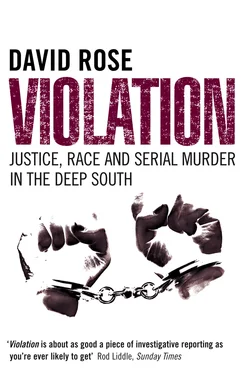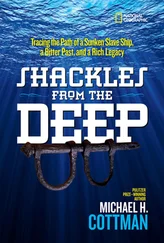1 ...6 7 8 10 11 12 ...25 When Jesse Thornton, the first police officer to respond to Dixon Olive’s call, arrived at Ferne Jackson’s house, he could see no sign that anyone had forced an entry. The doors were locked, the windows unbroken, and had he not been alerted by Mr Olive and some of Ferne’s neighbours, he would have been tempted to leave. But her car, they pointed out, was missing. Thornton spoke by radio to his patrol commander, who advised him to get inside the house and look around. He used the knife he always carried to remove the mesh insect screen from the living-room window, and to jiggle the lock until he could get it open.
Many years later, Thornton would tell a murder trial jury what he did next. The first space he came to was the hallway, and straight away, ‘I could see something that wasn’t right.’ Ferne’s approach to tidiness was as meticulous as her time-keeping. But in the hall, said Thornton, ‘There was stuff laying on the floor, papers, articles, just scattered all over the floor. There was a pillow on the floor, there was a suitcase that was opened, the drawers had been opened on the dresser, and stuff was pulled out and hanging out of it.’ He continued, very slowly, down the passage towards Ferne Jackson’s bedroom, his hand poised over his weapon. ‘Once I got to the bedroom, I looked inside,’ Thornton said. ‘That’s when I saw the body on the bed.’
Ferne’s sheets had been pulled up round her head, and her nightgown tugged upwards, in order to expose her hips, pubic area and waist. Thornton could see there was blood on the sheets.
It fell to the Columbus medical examiner, Dr Joe Webber, to conduct a post mortem. The killer, he wrote in his subsequent report, had tied a nylon stocking and a dressing-gown cord together to make a single ligature, which was wrapped around Mrs Jackson’s neck three times, leaving three ‘very deep crevasses’. There was a large area of haemorrhage and bruising on the left side of her face and head, so that the white of her left eye was ‘almost obliterated’ by bleeding; the result, he believed, of a massive blow to her head. The white of her right eye was a mass of tiny, pinpoint petechial haemorrhages where her blood, deprived of oxygen, had burst from its vessels close to the surface, a common sign of strangulation. The small hyoid bone at the front of the throat was fractured, and there was more bleeding inside her neck. Her brain was swollen, another symptom associated with an interruption to the blood supply. Her sternum, or breastbone, had been fractured, an act which would have required the application of enormous force: ‘It apparently had been flexed and pressure applied to the point that the bone snapped about midway between the upper and lower ends.’ Finally, her vagina was bloodied, torn and bruised. Although Dr Webber could not find spermatozoa, he felt it would be reasonable to conclude that Ferne Jackson had been raped. Later, traces of seminal fluid would be found on her sheet.
There was no obvious motive for Ferne’s murder. Despite ransacking her house, the killer had left her jewellery and other valuables untouched. She was still wearing two diamond rings. Nor did she have any enemies, and her popularity as a selfless public servant made her death all the harder to bear. ‘She was one of the unsung heroes who quietly, gently and persistently worked for the betterment of her community,’ Dr Mary Schley, a local paediatrician, told the Columbus Ledger. ‘Ferne Jackson fought for the underprivileged, the minority groups, and against poverty and for better mental health,’ added A.J. Kravtin, one of many readers who wrote to the paper after she died. While no one knew who was responsible, ‘if it turns out to be one of the above, they killed the wrong person. They killed a friend.’
Three days after the discovery of her body, the Ledger published an editorial in her memory. ‘It’s always tragic when an innocent person becomes the victim of a violent crime,’ it began, somewhat prosaically. ‘It’s even more tragic when the victim is someone who has devoted his or her life to helping others.’ What could be done about the kind of crime that had taken Mrs Jackson’s life, the paper asked, and how could further such acts be prevented? Increased police patrols would help. ‘Vigorous efforts to apprehend the assailant and assure him a swift trial and appropriate punishment, if found guilty, might deter others from committing similar crimes … Greater emphasis on respect for law and expanded educational and job opportunities might get at some of the underlying factors.’ It was not to be that simple.
Ferne Jackson was murdered barely a month after the capture of David Berkowitz, the sexually driven ‘Son of Sam’ who killed or seriously injured a dozen women in New York. Partly in response to Berkowitz’s bloody but compulsive career, Robert Ressler, the founder of the FBI’s Behavioral Science Unit at Quantico, Virginia, had coined a new term to describe the perpetrators of such actions – they were, he suggested, ‘serial killers’. The phrase had swiftly gained widespread currency. It took just eight days after the murder of Mrs Jackson for it to become apparent that one was at large in Columbus.
Jean Dimenstein was seventy-one, a wealthy spinster from Philadelphia who owned and ran a small department store, Fred and Jean’s, with her brother. She spent the evening of 24 September with two friends at a steakhouse on Macon Road. They drove her home a little before 10 p.m., and watched from the car as she let herself into her house on Twenty-First Street, about half a mile from the residence of Mrs Jackson. As usual, she used the door at the side of the house, which led into her kitchen from her carport. Some time later that night, working in absolute silence, the killer removed the pins from the door’s hinges, laid them to one side and entered Miss Dimenstein’s house. Her sister-in-law, Francine, arrived there for coffee at ten the following morning. She noticed at once that Jean’s car was missing, saw the open doorway, and called the police.
Like Ferne Jackson, Jean Dimenstein had been beaten about the head, strangled with a ligature made from a stocking wrapped around her neck three times, and raped. She was wearing the two diamond rings and, beneath the ligature, the diamond necklace she had worn the previous night. Although her house was also ransacked, it appeared that again, nothing had been stolen. To the chagrin of the police, who were cautiously claiming that they couldn’t be sure that Jackson and Dimenstein had been killed by the same assailant, J. Donald Kilgore, Columbus’s coroner, told the Ledger of the similarities between the two murders. He was, he said, quite certain that there was only one Columbus strangler. As if the bubbling panic that began to seize the city needed further encouragement, Kilgore informed journalists of supposed details that were not borne out by later investigations: that ‘some sort of inflexible object was used to violate the women’, and that ‘a pillow was used to muffle their horrified screams while [they were] being tortured sexually before their death’. The motive for the crimes, he proclaimed, was torture.
In the autumn of 1977, Kilgore had been in his post for a year. He was not, however, a qualified forensic scientist, nor a pathologist, but the former director of a funeral home who had been embalming bodies with unusual enthusiasm since his teens. ‘By the time I was twenty-one, I had participated with embalming 1,500 bodies,’ he once told a Columbus reporter. ‘You’ve got to disassociate yourself from the body at such times, even if the body has been mutilated. You try to associate with something positive. For instance, I don’t see blood. I see ketchup.’ Kilgore said that ‘I treat every person’s body with respect. I always have.’ But as time went on, growing numbers of police officers came to disagree, accusing him of ‘aggressive investigation and handling of the remains’ at murder scenes. Some filed official complaints. In 1989, the tension between Kilgore and the Columbus Police Department (CPD) reached a new peak when he was accused of and investigated for allegedly decapitating a suicide victim. Under Georgia law, only a qualified medical examiner could cut into a body during a post mortem, and Kilgore was forced to admit that he often did so before such a person arrived. However, he insisted that he had not removed the victim’s head. He had merely ‘performed a procedure that involved the opening of the top portion of the skull’.
Читать дальше












